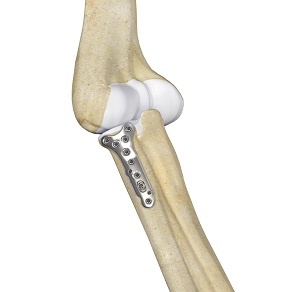
What is Radial Head ORIF and Replacement?
Open reduction and internal fixation (ORIF) of the radial head is a surgical technique employed for the treatment of a radial head fracture to restore normal anatomy and improve range of motion and function.
While conservative methods of immobilization or surgical fixation with screws can effectively treat minor fractures, multiple and severe fractures and dislocation of the elbow joint usually require removal of the radial head and replacement with a prosthesis and is known as a radial head replacement.
Anatomy
The elbow joint is formed by the junction of the humerus (upper arm bone), and radius and ulna (forearm bones). The radius is the shorter of the two forearm bones and can be divided into the head, neck, and body. The radial head articulates with the humerus and ulna to form the elbow joint. Fractures of the radius frequently occur in the part of the bone closest to the elbow, called the radial "head,” hence radial head fracture is defined as a break in the radial head bone of the elbow.
Indications for Radial Head ORIF and Replacement
General indications for radial head open reduction and internal fixation include:
- Large articular surface fragments
- Displaced radial fractures
- Severe fractures or ligament injuries
- Bone displacement of greater than 2 mm
- Mechanical obstruction to forearm rotation
General indications for replacement of the radial head include:
- Failure in conservative methods
- Fixation with screws is not feasible
- When removal of the radial head causes instability
- Arthritis
- Wear and tear
- Severe injury or fracture
Preparation for Radial Head ORIF and Replacement
Prior to open reduction and internal fixation of the radial head fracture and replacement, you may have:
- Physical exam to inspect blood circulation and nerves affected by the fracture
- X-ray, CT scan, or MRI scan to assess surrounding structures and broken bones
- Blood tests
- Depending on the type of fracture you have sustained, you may be given a tetanus shot if you are not up to date with your immunization
- A discussion with an anesthesiologist to determine the type of anesthesia you may undergo
- A discussion with your doctor about the medications and supplements you are taking and if any should be stopped
- A discussion about the need to avoid food and drink past midnight the night prior to your surgery
Procedure for Radial Head ORIF and Replacement
Open reduction and internal fixation of the radial head is most often employed to treat severe radial head fractures.
The surgery is performed under sterile conditions in the operating room under general anesthesia. After sterilizing the affected area, your surgeon will make an incision around the forearm muscles. Your surgeon will locate the fracture by carefully sliding in between the muscles of the forearm. The cuts from the injury and surfaces of the fractured bone are thoroughly cleaned out. After carefully visualizing the fracture, the bone fragments are first repositioned (reduced) into their normal alignment. The fragments of bone are then held in place with wires, screws, pins, or metal plates attached to the outer surface of the bone. After securing the bone, the incisions are closed by suturing or staples along with sterile dressings to complete the operation.
To perform a radial head replacement, your doctor makes an incision at the side of the elbow. All the fragments of the broken bone are carefully removed without injuring the surrounding tissues. Your surgeon determines the correct size of the prosthesis to facilitate a perfect fit. The radial neck is trimmed to receive the prosthesis. The central cavity of the radial body just below the radial neck is removed with an awl. Your surgeon then inserts the chosen prosthesis and checks for stability and tracking during various movements of the arm. The prosthesis is then cemented into position and the incision sutured.
Postoperative Care
Postoperative instructions and care for the management of ORIF and replacement include:
- Use of assistive devices such as a sling, cast, or splint to immobilize the bone and allow healing
- Limited weight-bearing activities
- Dressing, bandage, and bathing care
- Physical therapy and exercise regimen
- Adherence to medications
- Adherence to follow-up appointments
- Follow activity restrictions
Risks and Complications of Radial Head ORIF and Replacement
As with any surgery, some of the potential risks and complications of open reduction and internal fixation of radial head and replacement may include:
- Bleeding
- Swelling
- Infection
- Pain
- Anesthetic complications
- Damage to nerves and blood vessels
- Hardware irritation
- Fracture nonhealing
- Repeat surgery
- Broken bone
- Stiffness or instability of the joint
- Prosthetic failure
Advantages of Radial Head ORIF and Replacement
Advantages of radial head open reduction and internal fixation and replacement include:
- Allows optimal reduction
- Allows visibility and direct access to reduce fragments with advanced devices
- Preservation of soft tissues
- Minimal damage to blood vessels and nerves
- Minimal damage to surrounding tissues
- Minimal blood loss
